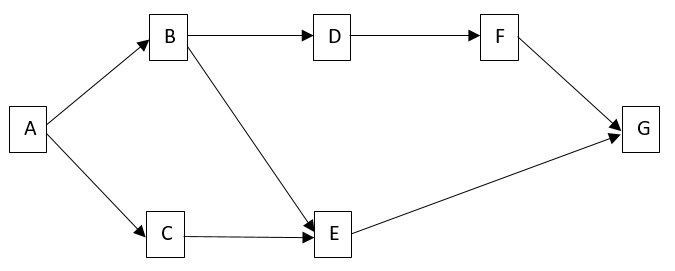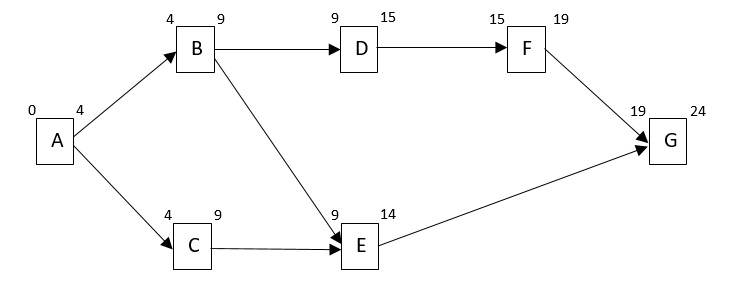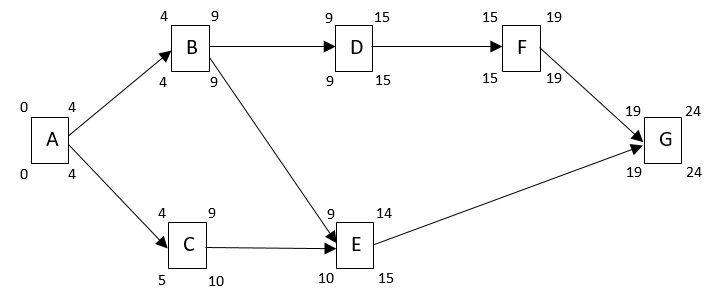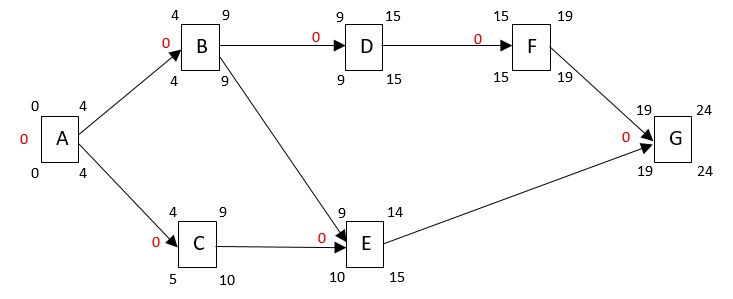How PERT builds up on CPM
In project management it is necessary to use a tool which states how the project is going. The project manger face the challenge of planning, coordinating and monitoring the project, which can be difficult if no tool is at hand [1]. Therefore, project managers often use the Critical Path Method (CPM) and Program Evaluation Review Technique (PERT) to do those things. The tools give a good overview of how a project progresses. Over the years, CPM and PERT have been used in a white range of projects. For example, in building constructions, maintenance of equipment, design and installation of management systems, organizing transportation projects and so many more. [2]
The critical path method organizes project’s tasks, which need to be done to complete a project, and estimate how much time it will take. Also, the method shows what tasks are sensitive in a project because these tasks may take more time. [3] This method shows visually how the tasks relate to one and another. [4] Therefore, the key essence of the critical path method is to compute the shortest time, which a project can take, by valuating task according to its predecessors.
As for program evaluation review technique, the method also shows visually how the tasks relate to one and another as CPM does. However, PERT takes into account that the duration of a task is not always known. So, the method uses three estimated time to calculate most likely duration of a tasks and hence the project as a whole. [5]
In this article will first go through the history of the methods and how the critical path method has been improved over the years. Then, some key concepts will be described and defined. Furthermore, the critical path method and PERT will be explained and an example taken and calculated to see how the methods work. Advantages and limitations of these methods will be listed and described. In the end, will be gone through what the differences are of CPM and PERT.
Contents |
History
The history of project management tools like the critical path method can be traced back to ancient Egypt. For example, when ancient Egyptians build the Great Pyramid of Giza, which stands near Cairo. That project was more than 5.000 years ago. The pyramid was built out of more than two million blocks of stone. The pyramid took over 20 years in building and needed much manpower which was divided into four construction teams. [6]
However, modern project management did not begin until 1900s when the Gantt chart was created. It was Henry Gantt and Fredrick Taylor that designed a graphical method to plan and control a work schedule and recording its progress. Over the years Gantt charts have been used, for example in 1931 when Hoover Dam was in build. It is still in use today because the chart can be easily understood. [6]
Furthermore, in 1956 the critical path method was used to deal with the interrelationships of separate tasks in a project schedule. The Dupont chemical company and Remington Rand Univac, a computer firm, thought up the method because they had a joint venture. However, it was not until 1958 that the method was first tested. It was on a construction project of a new chemical plant. The critical path method was then used again in 1959 to shutdown a plant at Louisville, Kentucky. [6]
Independent of the critical path method, in 1958, the U.S Navy’ Special Projects Office, along with Lockheed Missile System and Booz Allen & Hamilton developed Program Evaluation Review Technique (PERT) for a missile program called Polaris. The reason why the U.S. government wanted to develop the tool was to ensure that the Polaris program was completed. Also, the U.S. government had concern about the number of nuclear weapons which the Soviet Union was manufacturing. CPM and PERT both were designed to deal with the relationship between tasks in a project. However, PERT aimed to control over 3.000 contractors on the missile program but really the tool showed visually the major tasks and their relationship. As for the difference in function of the methods, PERT just showed the time interval but did not tackle the cost and quality issues faced by commercial firms. [6]
Improvements of the CPM
Since the development of the critical path method there have been made couple of improvements on it. First there was the Theory of Constraints which was formulated in the 1980s by the physicist Eliyahu Goldratt. [6] The theory is a methodology to analyse which factor is most likely to cause delay and then to improve that factor until it is no longer a bottleneck. [7] Then in 1997 the concept of the Critical Chain was introduced by Goldratt, when he published a book with that name. This improved method says to keep a project on schedule it is necessary to emphasize on its resources and the flexibility required in the resources. Also, the method adds uncertainty buffers to the project schedule so it can be ready for unpredictable problems which may arise. [6]
Definitions
To be able to understand the critical path method it is necessary to define some key concepts. In a project there are couple of paths, which are a sequence of connected tasks from the beginning of the project until the end. The sum of the time, which the tasks in the path take, is the length of the path. [5] The longest sequence of tasks, which has to be complete so a project can be finished, is the critical path. Hence, a task on the critical path cannot begin before its predecessors have been completed. Therefore, if there is a delay in one of the tasks, which is on the critical path, the project will also delay. [8] Project can have more than one critical path but all critical paths, in it, have the same length. [5] Later in the essay, will be shown an example of a critical path.
To find the earliest and latest schedules to avoid delays in the project are crucial. Hence, the following information is calculated for each task in the project.
• The earliest start time (EST) which means the earliest time a task can start if there will not be a delay in the project.
• The earliest finish time (EFT) indicates the earliest time a task can end if there will not be a delay in the project.
• The latest start time (LST) means the latest time a task can start if there will not be a delay in the project.
• The latest finish time (LFT) is the latest time a task can finish if there will not be a delay in the project. [5]
The Critical Path Method
Before starting to use the critical path method it is crucial to make a chart. The first thing is to list all tasks in the project. In the list it is needed to specify the task, description, predecessors and estimated time. Then, make a graph with notes, indicating each task, and arrows which indicate the connection between them. All arrows go from left to right and they begin at the first task, which has no predecessor, and go all the way to the last task, which has no successor. [9] The notes have to include space for the EST, EFT, LST, LFT and slack, as shown in figure 1. When the graph has been made the critical path method can be started.
The critical path method depends on EST, EFT, LST and LFT. The EST and EFT are calculated with a forward pass, but on the other hand the LST and LFT with a backward pass. In the forward pass a time is computed from the starting task to the finish one. As for the backward pass it is gone from the finish task to the starting one. How this is done will be explained in the upcoming paragraphs and an example taken in the next section. [5]
The basic of a forward pass is that all the predecessors connected to the task must be finished before it can begin. Let t be duration of a task and then it is possible to calculate EFT of a task if there is no delay. [5]
-
 Equation 1
Equation 1
As a result from the equation above the EFT of the latest task is the EST for the next, called the EST rule. This will be shown below in the example section. The forward pass may be formulated as follows: [5]
1. All tasks which has know predecessor get EST = 0.
2. All tasks which have known EST, compute EFT using Equation 1.
3. Apply the EST rule to get EST for next task.
4. Repeat step 2 and 3 until all tasks have EST and EFT. [5]
The basic of a backward pass is a task can begin at the latest time if and just if all its predecessors are finished, it is called the LFT rule. Therefore, each task has the latest finish time equal to the smallest latest start times of the task which follows. Hence, the latest start time can be computed from equation below, if there is no delay in the project. [5]
 Equation 2
Equation 2
The backward pass starts when the EFT for the last task has be found with the forward pass and then calculated from the end task to the first task. The backward pass can be formulated as follows: [5]
1. Set LFT equal to EFT at the finish task and at all tasks which do not have successors.
2. For all tasks where LFT value is known, compute LST using Equation 2.
3. The LST from the successor becomes the LFT for every new task, the LFT rule.
4. Repeat step 2 and 3 until all tasks have LFT and LST. [5]
The length of time which do not delay a project is the slack time. It is necessary calculate the slack time to identify the critical path(s), either with the start times or the finish times. If the slack time is equal to zero the task is part of the critical path. This can be done with following equation: [5]
 or
or  Equation 3
Equation 3
Example of CPM
As mentioned in the section above, here will be taken an example with the critical path method. In the example, the critical path will be found and the duration of the project. In reality the project manager would list the tasks, its predecessor and duration of each task. However, in this case that has already been done in the table below.
| Task | Predecessor | Time |
| A | – | 4 |
| B | A | 5 |
| C | A | 5 |
| D | B | 6 |
| E | B, C | 5 |
| F | D | 4 |
| G | F, E | 5 |
First of all draw a diagram, then the procedure of the project becomes visual. Also, it becomes easier to calculate the EST, EFT, LST, LFT and slack for each task. Therefore, the diagram for this specific project will be:
Then, start to calculate EST and EFT for each tasks starting on the first task until all EST and EFT have been computed, use Equation 1. Here it is good to remember that the EST for the first task, here task A, equals 0 and the EST of the successor is the EFT of the task before. If the task depends on two previous tasks the EFT which is higher is chosen.
When forward pass has been applied it can be seen that the total duration of the project is 24. To find the critical path, it is necessary to find the LST and LFT. To do so, the backward pass is used. Task G has the EFT = 24 therefore LFT = 24, as explained in the method section. When that is known, equation 2 can be applied to find LST and LFT for each task. Remember that LFT is equal to the LST of the successor. If the task has two or more successors the lowest number is chosen.
Now, the slack of each task is found by using Equation 3. In the diagram the slack is marked in red.
From the diagram above it can be seen that the critical path is the path A-B-D-F-G, since tasks C and E both have 1 in slack.
To sum the solution up, the forward pass gave the solution of the project time, which was 24, and when finished applying the backward pass and slack the critical path was found, which was A-B-D-F-G.
CPM's advantages
All methods have proc and cons and the critical path method is no exception of that. Hence, to be able to fully understand and use the method it is necessary to list the advantages. The advantages of the critical path method are:
1. Helps finding out how the time schedule for the tasks should look like according to their relation. [10]
2. Controlling of a project becomes easier for the management. [10]
3. Identifies the critical tasks in a project. Hence, it shows the management which tasks should be observed closely. [10]
4. Possible to become more detailed in planning of a project.[10]
5. Makes it possible to calculate slack of each task. [11]
6. Motivates the manager to shorten the time of the project. The manager can do so by optimize the critical path and use compression techniques. [11]
7. Enhances visibility of changes’ impact in a schedule, which almost always needs to be done in reality. [11]
CPM's limitation
As with the advantages, to use the CPM properly it is necessary to know the gaps in the method. Then it is possible to respond to them accordingly. The CPM has the following limitations:
1. Assumes that accurate duration of each task in a project is known. In real life that may not be true. [10]
2. The estimated time is not based on statistical analysis. [10]
3. For large projects, which have many tasks, it can be hard to print the project diagram and hang it on the wall. Also, in those cases it would be almost in possible to map the relationships. Hence, now there are used software to do so. [11]
4. In some cases the controlling of the project can be difficult, since there can be many tasks in a project and a delay can change the whole diagram. [10]
Program Evaluation and Review Technique
When the period of a task is uncertain the critical path method cannot be used. However, in those cases program evaluation and review technique analysis can be applied. The analysis depends on three types of estimated durations for a task, as in CPM there is only single value: [5]
1. The optimistic duration a indicates the time which a task will take under the best conditions.
2. The pessimistic duration b means the time which a task will take under the worst conditions.
3. The most likely duration m is the time which is the most realistic for a task to be completed. Under normal condition this is the time the task will take. [5]
Hence, the period of a task is assumed to have a beta probability distribution in the analysis. From the variables above the expected activity time,  , and the variance of the task completion time,
, and the variance of the task completion time,  , can be calculated as follows: [5]
, can be calculated as follows: [5]
 Equation 4
Equation 4
 Equation 5
Equation 5
From the equations above the expected completion time of the project,  , can be obtained and the variability in the project completion time,
, can be obtained and the variability in the project completion time,  , as follows: [5]
, as follows: [5]
 Equation 6
Equation 6
 Equation 7
Equation 7
PERT analysis provides answers for question about the critical path(s), the beginning and finish times of tasks, project’s expected completion time and it takes in to account variability of the completion time for the project. Furthermore, estimates whether or not the project will be on time. Also, the analysis can estimate with a given probability how long the completion time is in the project. [5]
Example of PERT
The example for the CPM is also used here. Know the time from that example is shown as the normal time and as before the project manager have already put in the integers, as shown in the table below.
| Task | Predecessor | Time | ||
| Opt. (a) | Normal (m) | Pess. (b) | ||
| A | – | 2 | 4 | 6 |
| B | A | 3 | 5 | 9 |
| C | A | 4 | 5 | 7 |
| D | B | 4 | 6 | 10 |
| E | B, C | 4 | 5 | 7 |
| F | D | 3 | 4 | 8 |
| G | F, E | 3 | 5 | 8 |
WIP – CALCULATION!!!
PERT's advantages
To know methods advantages is necessary for everyone how are going to practice them. When the advantages are know the calculation and solution will be understandable and the usage of the method will be easier. PERT is no exception of that and therefore some of PERT's advantages have been listed below.
1. Makes the management think carefully if the various tasks are pertinent for the project. [12]
2. Can easily be used and understood. [13]
3. Makes it possible to predict time of a project. [12]
4. Finds the probability of the duration, both for each task and the whole project, and therefore enable determination of that. [12]
5. Helps coordinate various tasks in a project. [12]
6. Shows if there are any delays or ahead of schedule in a project. [13]
PERT's limitation
All methods have some limits and the critical path method and PERT are no exception of that. To know them is crucial to be able to see the gaps in the method and respond accordingly. In this section it will be demonstrated PERT's limitations.
1. Depends on that all tasks are known beforehand. In some projects, such as in research and development, that is not possible. [12]
2. Assumes that tasks can be sub-divided into pre known and separate tasks, but in reality this is not always possible. [12]
3. Only takes into account time but not cost. Therefore, the method can choose expensive task, which takes shorter time then its cheaper counterpart. [12]
4. The duration of each task is estimates therefore it may be an error in the estimated time. [12]
5. Requires frequent updating and recalculating, which is expansive and time consuming. Because of the updating and recalculations there is need for highly trained staff. [12]
6. Depends on that relationships between tasks should be known beforehand. As mentioned above, all tasks cannot always been known before a project starts therefore the relationships of those tasks cannot be known. Also, some tasks are difficult to put on one particular place. [13]
7. Focuses too much on the critical path but not the other tasks, which are not a part of the critical path. Hence, the tasks, which are not critical, may be forgotten in the process. [13]
8. Depends on that the time follows Beta PB but that is not necessarily true in reality. [13]
How PERT builds upon CPM
WIP!!! TALK SOMETHING ABOUT THE DIFFERENCE BETWEEN THE METHODS!! THEIR DIFFERENCE IN ADVANAGES, LIMITATIONS AND SO ON HTTP://WWW.MATH.UPATRAS.GR/~TSANTAS/DOWNLOADFILES/HILLIER&LIEBERMAN_7TH-EDITION_CHAPTER10.PDF HTTP://KEYDIFFERENCES.COM/DIFFERENCE-BETWEEN-PERT-AND-CPM.HTML
Reference
- ↑ http://www.careerprofiles.info/project-management-interview.html
- ↑ http://www.math.csusb.edu/faculty/prakash/611/Project_Management.ppt.pdf
- ↑ http://smallbusiness.chron.com/characteristics-critical-path-method-66136.html
- ↑ http://www.businessdictionary.com/definition/critical-path-method-CPM.html
- ↑ 5.00 5.01 5.02 5.03 5.04 5.05 5.06 5.07 5.08 5.09 5.10 5.11 5.12 5.13 5.14 5.15 5.16 Project Scheduling: CPM/PERT, http://learngroup.org/uploads/2015-01-02/Lecture_-_Project_Management_%28Overview%29.pdf
- ↑ 6.0 6.1 6.2 6.3 6.4 6.5 http://smallbusiness.chron.com/history-critical-path-method-55917.html
- ↑ http://www.leanproduction.com/theory-of-constraints.html
- ↑ http://www.businessdictionary.com/definition/critical-path.html
- ↑ https://www.mindtools.com/critpath.html
- ↑ 10.0 10.1 10.2 10.3 10.4 10.5 10.6 http://www.yourarticlelibrary.com/business/planning-business/critical-path-method-cpm-definition-advantages-and-limitations/40754/
- ↑ 11.0 11.1 11.2 11.3 http://www.brighthubpm.com/project-planning/60960-advantages-and-disadvantages-of-critical-path-method/
- ↑ 12.0 12.1 12.2 12.3 12.4 12.5 12.6 12.7 12.8 http://www.businessmanagementideas.com/business/pert-origin-methodology-advantages-and-limitations/535
- ↑ 13.0 13.1 13.2 13.3 13.4 http://www.allsyllabus.com/aj/note/Computer_Science/Operations%20Research/Unit6/Advantages%20and%20Limitations%20of%20PERT%20CPM.php#.V9qsfJh9600




